Unilever: Analysis of Technology's Impact on Business Performance
VerifiedAdded on 2021/09/08
|15
|3767
|477
Report
AI Summary
This report evaluates the impact of the 'rise of technology' megatrend on Unilever's performance, focusing on how digitalization creates opportunities and challenges. It examines the company's use of automation, advanced analytics, and artificial intelligence (AI) to improve efficiency, reduce costs, and enhance customer understanding. The report highlights the limitations of these technologies, such as job cuts and implementation costs, while providing recommendations including investment in research and development and addressing potential problems before implementation. The analysis covers Unilever's application of big data in China, automation in production, and AI in recruitment. The report concludes that compliance with these policies will increase Unilever's profitability and sustain its growth in the industry.
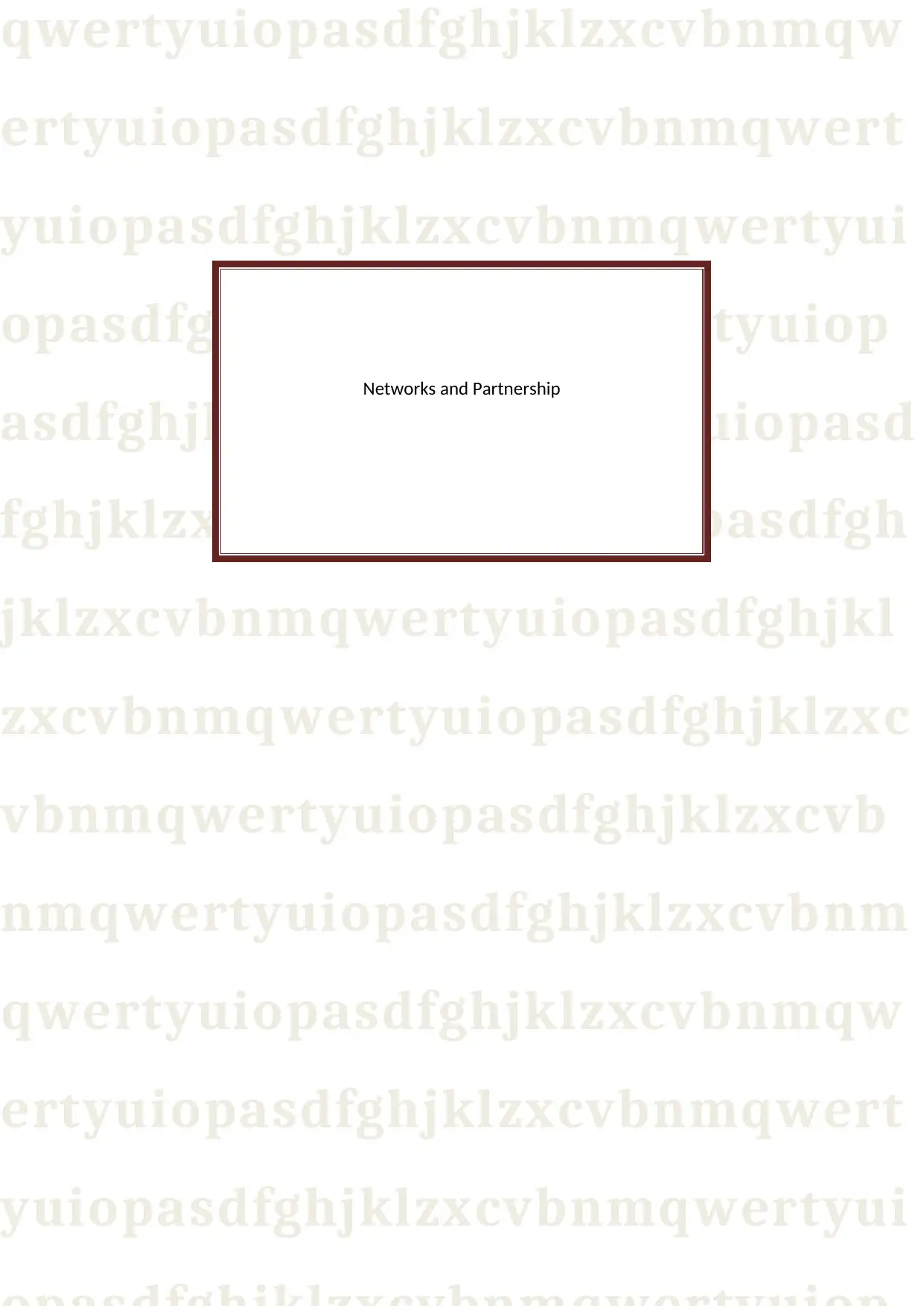
qwertyuiopasdfghjklzxcvbnmqw
ertyuiopasdfghjklzxcvbnmqwert
yuiopasdfghjklzxcvbnmqwertyui
opasdfghjklzxcvbnmqwertyuiop
asdfghjklzxcvbnmqwertyuiopasd
fghjklzxcvbnmqwertyuiopasdfgh
jklzxcvbnmqwertyuiopasdfghjkl
zxcvbnmqwertyuiopasdfghjklzxc
vbnmqwertyuiopasdfghjklzxcvb
nmqwertyuiopasdfghjklzxcvbnm
qwertyuiopasdfghjklzxcvbnmqw
ertyuiopasdfghjklzxcvbnmqwert
yuiopasdfghjklzxcvbnmqwertyui
Networks and Partnership
ertyuiopasdfghjklzxcvbnmqwert
yuiopasdfghjklzxcvbnmqwertyui
opasdfghjklzxcvbnmqwertyuiop
asdfghjklzxcvbnmqwertyuiopasd
fghjklzxcvbnmqwertyuiopasdfgh
jklzxcvbnmqwertyuiopasdfghjkl
zxcvbnmqwertyuiopasdfghjklzxc
vbnmqwertyuiopasdfghjklzxcvb
nmqwertyuiopasdfghjklzxcvbnm
qwertyuiopasdfghjklzxcvbnmqw
ertyuiopasdfghjklzxcvbnmqwert
yuiopasdfghjklzxcvbnmqwertyui
Networks and Partnership
Paraphrase This Document
Need a fresh take? Get an instant paraphrase of this document with our AI Paraphraser
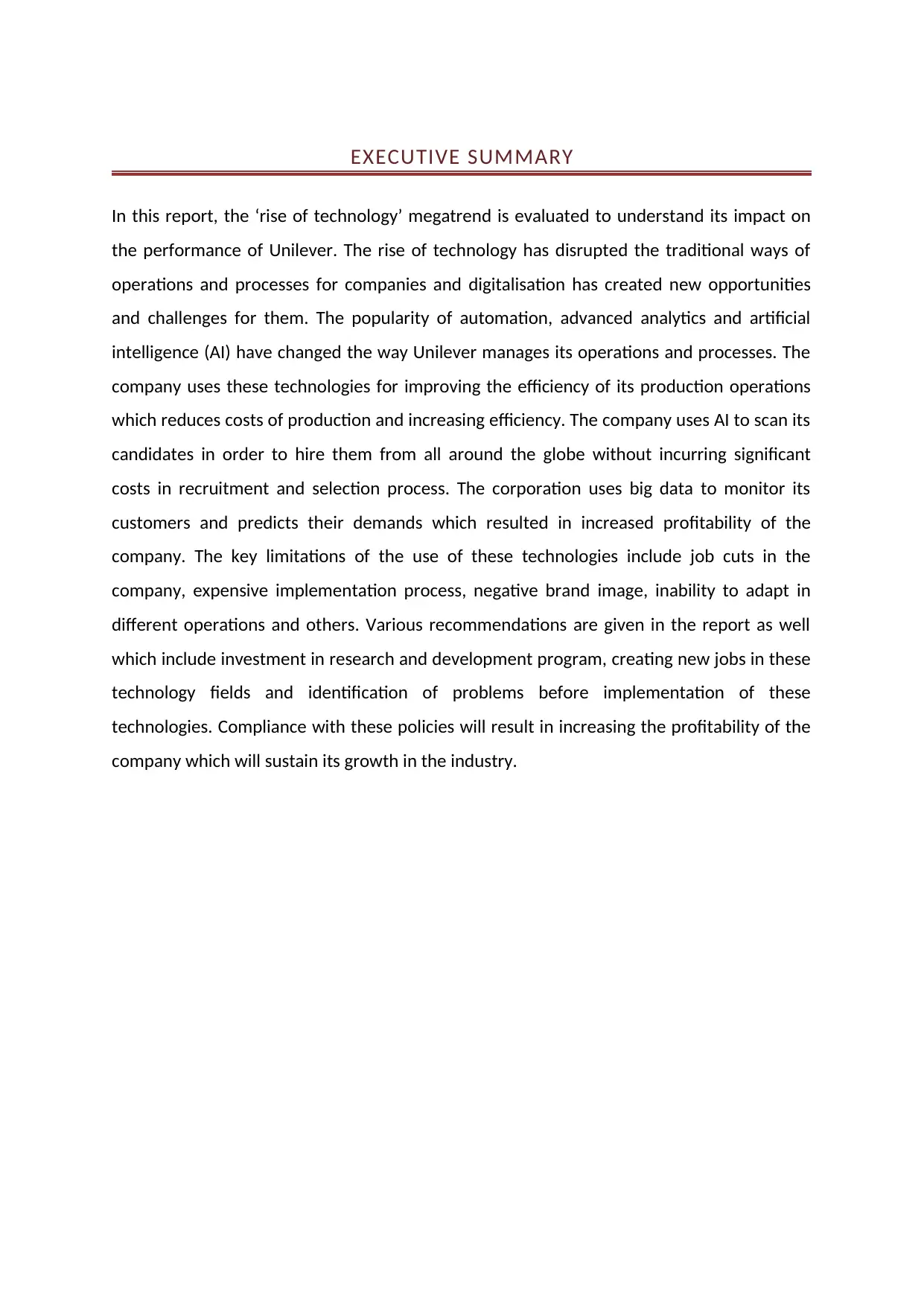
EXECUTIVE SUMMARY
In this report, the ‘rise of technology’ megatrend is evaluated to understand its impact on
the performance of Unilever. The rise of technology has disrupted the traditional ways of
operations and processes for companies and digitalisation has created new opportunities
and challenges for them. The popularity of automation, advanced analytics and artificial
intelligence (AI) have changed the way Unilever manages its operations and processes. The
company uses these technologies for improving the efficiency of its production operations
which reduces costs of production and increasing efficiency. The company uses AI to scan its
candidates in order to hire them from all around the globe without incurring significant
costs in recruitment and selection process. The corporation uses big data to monitor its
customers and predicts their demands which resulted in increased profitability of the
company. The key limitations of the use of these technologies include job cuts in the
company, expensive implementation process, negative brand image, inability to adapt in
different operations and others. Various recommendations are given in the report as well
which include investment in research and development program, creating new jobs in these
technology fields and identification of problems before implementation of these
technologies. Compliance with these policies will result in increasing the profitability of the
company which will sustain its growth in the industry.
In this report, the ‘rise of technology’ megatrend is evaluated to understand its impact on
the performance of Unilever. The rise of technology has disrupted the traditional ways of
operations and processes for companies and digitalisation has created new opportunities
and challenges for them. The popularity of automation, advanced analytics and artificial
intelligence (AI) have changed the way Unilever manages its operations and processes. The
company uses these technologies for improving the efficiency of its production operations
which reduces costs of production and increasing efficiency. The company uses AI to scan its
candidates in order to hire them from all around the globe without incurring significant
costs in recruitment and selection process. The corporation uses big data to monitor its
customers and predicts their demands which resulted in increased profitability of the
company. The key limitations of the use of these technologies include job cuts in the
company, expensive implementation process, negative brand image, inability to adapt in
different operations and others. Various recommendations are given in the report as well
which include investment in research and development program, creating new jobs in these
technology fields and identification of problems before implementation of these
technologies. Compliance with these policies will result in increasing the profitability of the
company which will sustain its growth in the industry.
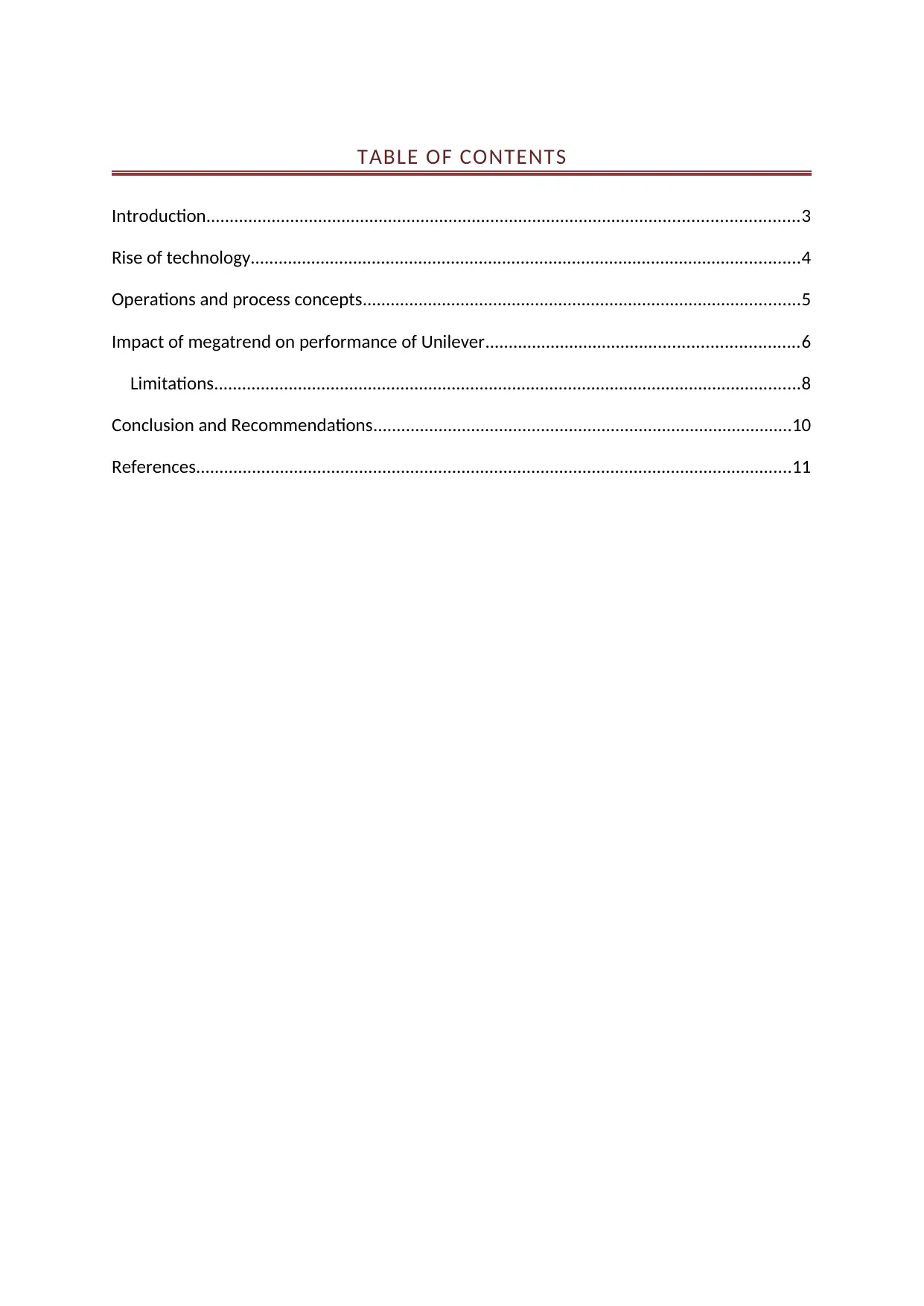
TABLE OF CONTENTS
Introduction...............................................................................................................................3
Rise of technology......................................................................................................................4
Operations and process concepts..............................................................................................5
Impact of megatrend on performance of Unilever...................................................................6
Limitations..............................................................................................................................8
Conclusion and Recommendations..........................................................................................10
References................................................................................................................................11
Introduction...............................................................................................................................3
Rise of technology......................................................................................................................4
Operations and process concepts..............................................................................................5
Impact of megatrend on performance of Unilever...................................................................6
Limitations..............................................................................................................................8
Conclusion and Recommendations..........................................................................................10
References................................................................................................................................11
⊘ This is a preview!⊘
Do you want full access?
Subscribe today to unlock all pages.

Trusted by 1+ million students worldwide
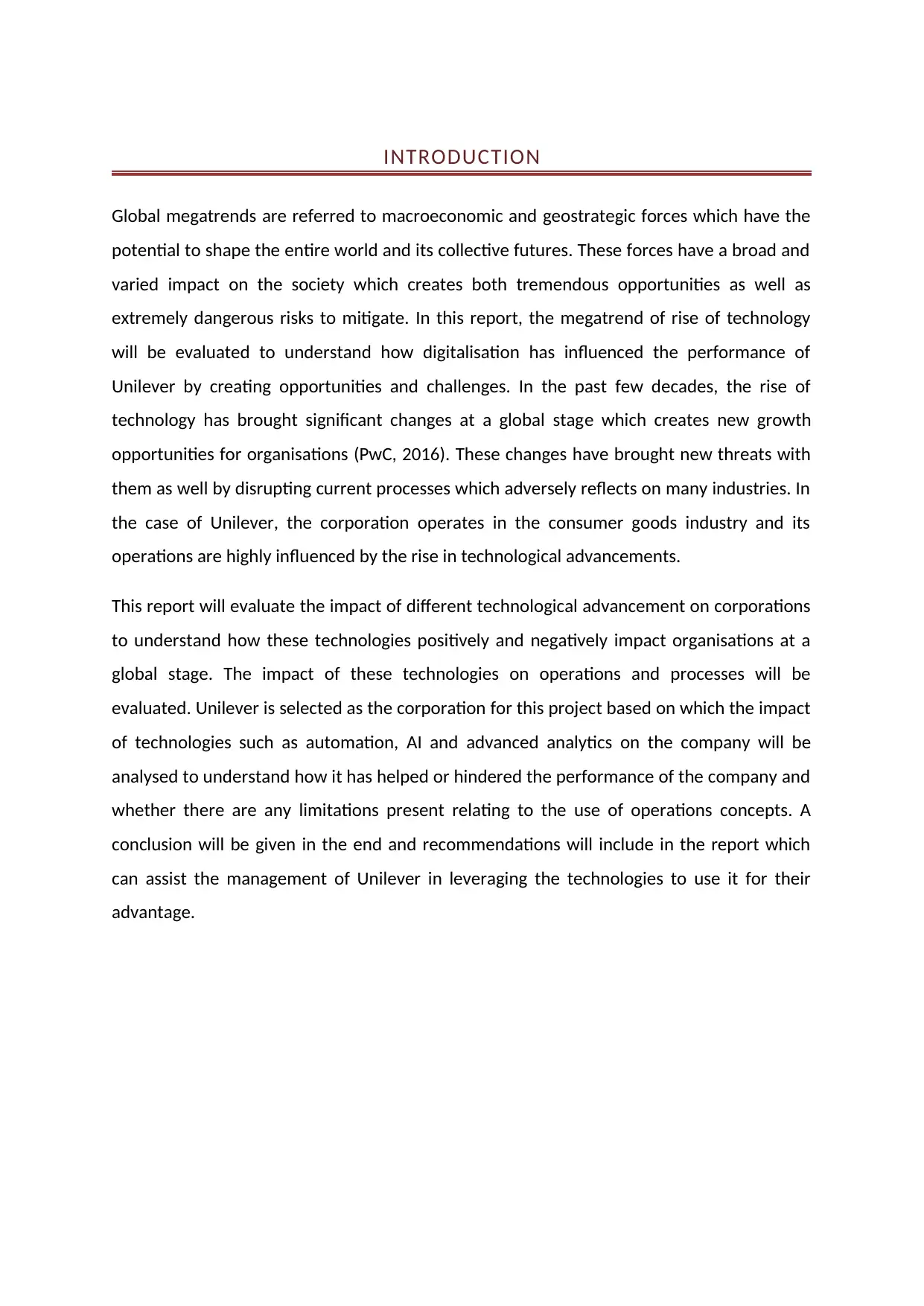
INTRODUCTION
Global megatrends are referred to macroeconomic and geostrategic forces which have the
potential to shape the entire world and its collective futures. These forces have a broad and
varied impact on the society which creates both tremendous opportunities as well as
extremely dangerous risks to mitigate. In this report, the megatrend of rise of technology
will be evaluated to understand how digitalisation has influenced the performance of
Unilever by creating opportunities and challenges. In the past few decades, the rise of
technology has brought significant changes at a global stage which creates new growth
opportunities for organisations (PwC, 2016). These changes have brought new threats with
them as well by disrupting current processes which adversely reflects on many industries. In
the case of Unilever, the corporation operates in the consumer goods industry and its
operations are highly influenced by the rise in technological advancements.
This report will evaluate the impact of different technological advancement on corporations
to understand how these technologies positively and negatively impact organisations at a
global stage. The impact of these technologies on operations and processes will be
evaluated. Unilever is selected as the corporation for this project based on which the impact
of technologies such as automation, AI and advanced analytics on the company will be
analysed to understand how it has helped or hindered the performance of the company and
whether there are any limitations present relating to the use of operations concepts. A
conclusion will be given in the end and recommendations will include in the report which
can assist the management of Unilever in leveraging the technologies to use it for their
advantage.
Global megatrends are referred to macroeconomic and geostrategic forces which have the
potential to shape the entire world and its collective futures. These forces have a broad and
varied impact on the society which creates both tremendous opportunities as well as
extremely dangerous risks to mitigate. In this report, the megatrend of rise of technology
will be evaluated to understand how digitalisation has influenced the performance of
Unilever by creating opportunities and challenges. In the past few decades, the rise of
technology has brought significant changes at a global stage which creates new growth
opportunities for organisations (PwC, 2016). These changes have brought new threats with
them as well by disrupting current processes which adversely reflects on many industries. In
the case of Unilever, the corporation operates in the consumer goods industry and its
operations are highly influenced by the rise in technological advancements.
This report will evaluate the impact of different technological advancement on corporations
to understand how these technologies positively and negatively impact organisations at a
global stage. The impact of these technologies on operations and processes will be
evaluated. Unilever is selected as the corporation for this project based on which the impact
of technologies such as automation, AI and advanced analytics on the company will be
analysed to understand how it has helped or hindered the performance of the company and
whether there are any limitations present relating to the use of operations concepts. A
conclusion will be given in the end and recommendations will include in the report which
can assist the management of Unilever in leveraging the technologies to use it for their
advantage.
Paraphrase This Document
Need a fresh take? Get an instant paraphrase of this document with our AI Paraphraser
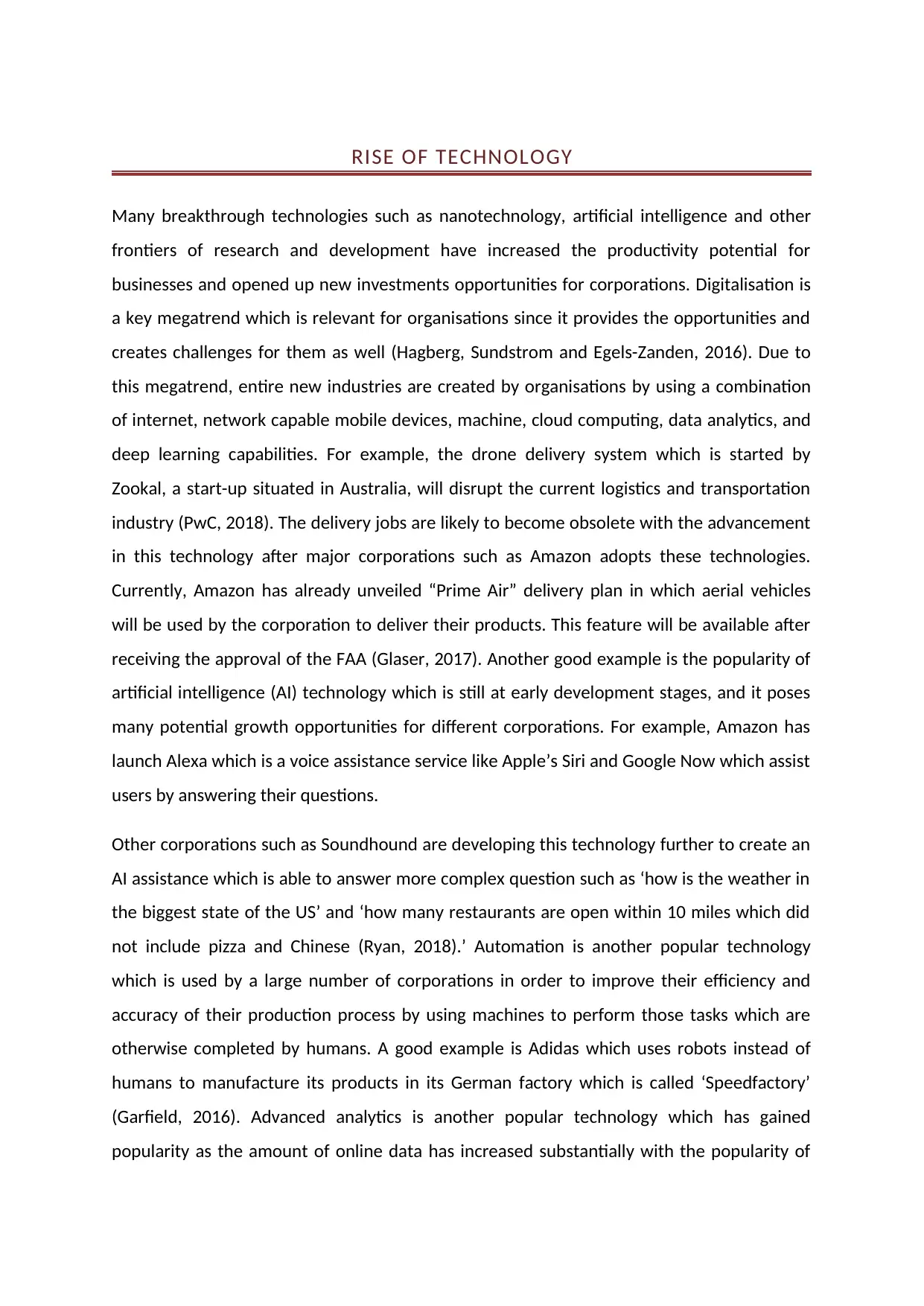
RISE OF TECHNOLOGY
Many breakthrough technologies such as nanotechnology, artificial intelligence and other
frontiers of research and development have increased the productivity potential for
businesses and opened up new investments opportunities for corporations. Digitalisation is
a key megatrend which is relevant for organisations since it provides the opportunities and
creates challenges for them as well (Hagberg, Sundstrom and Egels-Zanden, 2016). Due to
this megatrend, entire new industries are created by organisations by using a combination
of internet, network capable mobile devices, machine, cloud computing, data analytics, and
deep learning capabilities. For example, the drone delivery system which is started by
Zookal, a start-up situated in Australia, will disrupt the current logistics and transportation
industry (PwC, 2018). The delivery jobs are likely to become obsolete with the advancement
in this technology after major corporations such as Amazon adopts these technologies.
Currently, Amazon has already unveiled “Prime Air” delivery plan in which aerial vehicles
will be used by the corporation to deliver their products. This feature will be available after
receiving the approval of the FAA (Glaser, 2017). Another good example is the popularity of
artificial intelligence (AI) technology which is still at early development stages, and it poses
many potential growth opportunities for different corporations. For example, Amazon has
launch Alexa which is a voice assistance service like Apple’s Siri and Google Now which assist
users by answering their questions.
Other corporations such as Soundhound are developing this technology further to create an
AI assistance which is able to answer more complex question such as ‘how is the weather in
the biggest state of the US’ and ‘how many restaurants are open within 10 miles which did
not include pizza and Chinese (Ryan, 2018).’ Automation is another popular technology
which is used by a large number of corporations in order to improve their efficiency and
accuracy of their production process by using machines to perform those tasks which are
otherwise completed by humans. A good example is Adidas which uses robots instead of
humans to manufacture its products in its German factory which is called ‘Speedfactory’
(Garfield, 2016). Advanced analytics is another popular technology which has gained
popularity as the amount of online data has increased substantially with the popularity of
Many breakthrough technologies such as nanotechnology, artificial intelligence and other
frontiers of research and development have increased the productivity potential for
businesses and opened up new investments opportunities for corporations. Digitalisation is
a key megatrend which is relevant for organisations since it provides the opportunities and
creates challenges for them as well (Hagberg, Sundstrom and Egels-Zanden, 2016). Due to
this megatrend, entire new industries are created by organisations by using a combination
of internet, network capable mobile devices, machine, cloud computing, data analytics, and
deep learning capabilities. For example, the drone delivery system which is started by
Zookal, a start-up situated in Australia, will disrupt the current logistics and transportation
industry (PwC, 2018). The delivery jobs are likely to become obsolete with the advancement
in this technology after major corporations such as Amazon adopts these technologies.
Currently, Amazon has already unveiled “Prime Air” delivery plan in which aerial vehicles
will be used by the corporation to deliver their products. This feature will be available after
receiving the approval of the FAA (Glaser, 2017). Another good example is the popularity of
artificial intelligence (AI) technology which is still at early development stages, and it poses
many potential growth opportunities for different corporations. For example, Amazon has
launch Alexa which is a voice assistance service like Apple’s Siri and Google Now which assist
users by answering their questions.
Other corporations such as Soundhound are developing this technology further to create an
AI assistance which is able to answer more complex question such as ‘how is the weather in
the biggest state of the US’ and ‘how many restaurants are open within 10 miles which did
not include pizza and Chinese (Ryan, 2018).’ Automation is another popular technology
which is used by a large number of corporations in order to improve their efficiency and
accuracy of their production process by using machines to perform those tasks which are
otherwise completed by humans. A good example is Adidas which uses robots instead of
humans to manufacture its products in its German factory which is called ‘Speedfactory’
(Garfield, 2016). Advanced analytics is another popular technology which has gained
popularity as the amount of online data has increased substantially with the popularity of
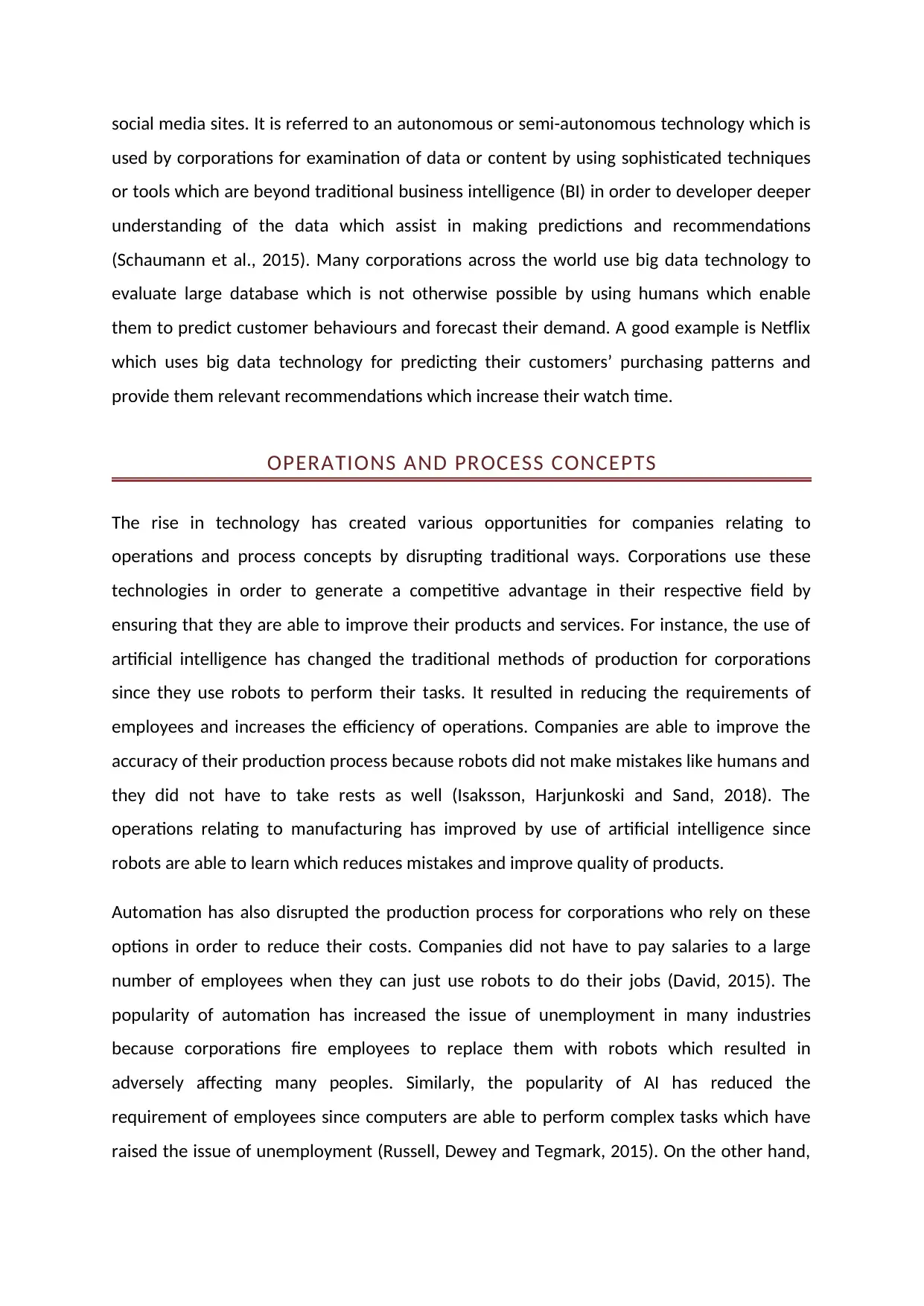
social media sites. It is referred to an autonomous or semi-autonomous technology which is
used by corporations for examination of data or content by using sophisticated techniques
or tools which are beyond traditional business intelligence (BI) in order to developer deeper
understanding of the data which assist in making predictions and recommendations
(Schaumann et al., 2015). Many corporations across the world use big data technology to
evaluate large database which is not otherwise possible by using humans which enable
them to predict customer behaviours and forecast their demand. A good example is Netflix
which uses big data technology for predicting their customers’ purchasing patterns and
provide them relevant recommendations which increase their watch time.
OPERATIONS AND PROCESS CONCEPTS
The rise in technology has created various opportunities for companies relating to
operations and process concepts by disrupting traditional ways. Corporations use these
technologies in order to generate a competitive advantage in their respective field by
ensuring that they are able to improve their products and services. For instance, the use of
artificial intelligence has changed the traditional methods of production for corporations
since they use robots to perform their tasks. It resulted in reducing the requirements of
employees and increases the efficiency of operations. Companies are able to improve the
accuracy of their production process because robots did not make mistakes like humans and
they did not have to take rests as well (Isaksson, Harjunkoski and Sand, 2018). The
operations relating to manufacturing has improved by use of artificial intelligence since
robots are able to learn which reduces mistakes and improve quality of products.
Automation has also disrupted the production process for corporations who rely on these
options in order to reduce their costs. Companies did not have to pay salaries to a large
number of employees when they can just use robots to do their jobs (David, 2015). The
popularity of automation has increased the issue of unemployment in many industries
because corporations fire employees to replace them with robots which resulted in
adversely affecting many peoples. Similarly, the popularity of AI has reduced the
requirement of employees since computers are able to perform complex tasks which have
raised the issue of unemployment (Russell, Dewey and Tegmark, 2015). On the other hand,
used by corporations for examination of data or content by using sophisticated techniques
or tools which are beyond traditional business intelligence (BI) in order to developer deeper
understanding of the data which assist in making predictions and recommendations
(Schaumann et al., 2015). Many corporations across the world use big data technology to
evaluate large database which is not otherwise possible by using humans which enable
them to predict customer behaviours and forecast their demand. A good example is Netflix
which uses big data technology for predicting their customers’ purchasing patterns and
provide them relevant recommendations which increase their watch time.
OPERATIONS AND PROCESS CONCEPTS
The rise in technology has created various opportunities for companies relating to
operations and process concepts by disrupting traditional ways. Corporations use these
technologies in order to generate a competitive advantage in their respective field by
ensuring that they are able to improve their products and services. For instance, the use of
artificial intelligence has changed the traditional methods of production for corporations
since they use robots to perform their tasks. It resulted in reducing the requirements of
employees and increases the efficiency of operations. Companies are able to improve the
accuracy of their production process because robots did not make mistakes like humans and
they did not have to take rests as well (Isaksson, Harjunkoski and Sand, 2018). The
operations relating to manufacturing has improved by use of artificial intelligence since
robots are able to learn which reduces mistakes and improve quality of products.
Automation has also disrupted the production process for corporations who rely on these
options in order to reduce their costs. Companies did not have to pay salaries to a large
number of employees when they can just use robots to do their jobs (David, 2015). The
popularity of automation has increased the issue of unemployment in many industries
because corporations fire employees to replace them with robots which resulted in
adversely affecting many peoples. Similarly, the popularity of AI has reduced the
requirement of employees since computers are able to perform complex tasks which have
raised the issue of unemployment (Russell, Dewey and Tegmark, 2015). On the other hand,
⊘ This is a preview!⊘
Do you want full access?
Subscribe today to unlock all pages.

Trusted by 1+ million students worldwide
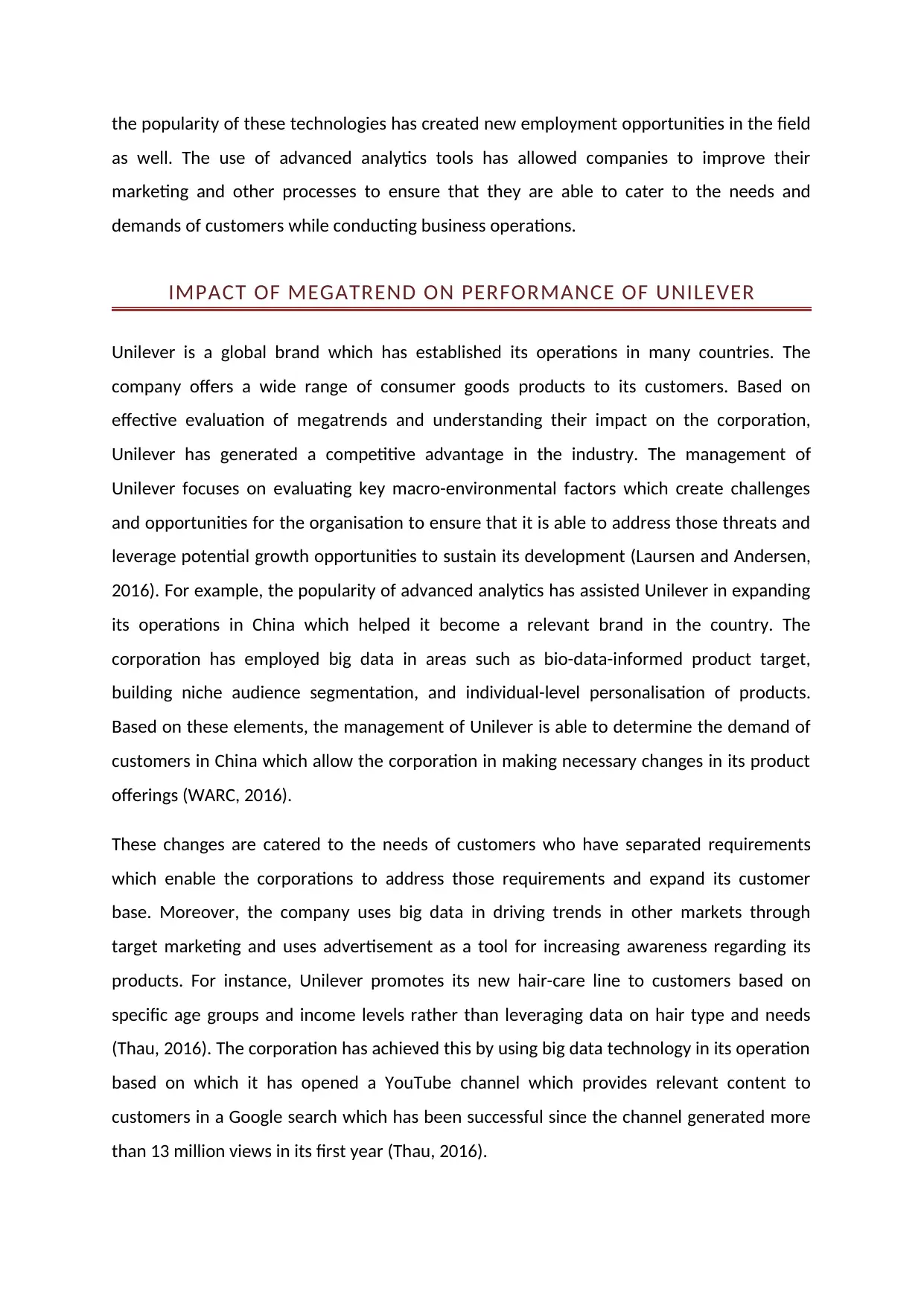
the popularity of these technologies has created new employment opportunities in the field
as well. The use of advanced analytics tools has allowed companies to improve their
marketing and other processes to ensure that they are able to cater to the needs and
demands of customers while conducting business operations.
IMPACT OF MEGATREND ON PERFORMANCE OF UNILEVER
Unilever is a global brand which has established its operations in many countries. The
company offers a wide range of consumer goods products to its customers. Based on
effective evaluation of megatrends and understanding their impact on the corporation,
Unilever has generated a competitive advantage in the industry. The management of
Unilever focuses on evaluating key macro-environmental factors which create challenges
and opportunities for the organisation to ensure that it is able to address those threats and
leverage potential growth opportunities to sustain its development (Laursen and Andersen,
2016). For example, the popularity of advanced analytics has assisted Unilever in expanding
its operations in China which helped it become a relevant brand in the country. The
corporation has employed big data in areas such as bio-data-informed product target,
building niche audience segmentation, and individual-level personalisation of products.
Based on these elements, the management of Unilever is able to determine the demand of
customers in China which allow the corporation in making necessary changes in its product
offerings (WARC, 2016).
These changes are catered to the needs of customers who have separated requirements
which enable the corporations to address those requirements and expand its customer
base. Moreover, the company uses big data in driving trends in other markets through
target marketing and uses advertisement as a tool for increasing awareness regarding its
products. For instance, Unilever promotes its new hair-care line to customers based on
specific age groups and income levels rather than leveraging data on hair type and needs
(Thau, 2016). The corporation has achieved this by using big data technology in its operation
based on which it has opened a YouTube channel which provides relevant content to
customers in a Google search which has been successful since the channel generated more
than 13 million views in its first year (Thau, 2016).
as well. The use of advanced analytics tools has allowed companies to improve their
marketing and other processes to ensure that they are able to cater to the needs and
demands of customers while conducting business operations.
IMPACT OF MEGATREND ON PERFORMANCE OF UNILEVER
Unilever is a global brand which has established its operations in many countries. The
company offers a wide range of consumer goods products to its customers. Based on
effective evaluation of megatrends and understanding their impact on the corporation,
Unilever has generated a competitive advantage in the industry. The management of
Unilever focuses on evaluating key macro-environmental factors which create challenges
and opportunities for the organisation to ensure that it is able to address those threats and
leverage potential growth opportunities to sustain its development (Laursen and Andersen,
2016). For example, the popularity of advanced analytics has assisted Unilever in expanding
its operations in China which helped it become a relevant brand in the country. The
corporation has employed big data in areas such as bio-data-informed product target,
building niche audience segmentation, and individual-level personalisation of products.
Based on these elements, the management of Unilever is able to determine the demand of
customers in China which allow the corporation in making necessary changes in its product
offerings (WARC, 2016).
These changes are catered to the needs of customers who have separated requirements
which enable the corporations to address those requirements and expand its customer
base. Moreover, the company uses big data in driving trends in other markets through
target marketing and uses advertisement as a tool for increasing awareness regarding its
products. For instance, Unilever promotes its new hair-care line to customers based on
specific age groups and income levels rather than leveraging data on hair type and needs
(Thau, 2016). The corporation has achieved this by using big data technology in its operation
based on which it has opened a YouTube channel which provides relevant content to
customers in a Google search which has been successful since the channel generated more
than 13 million views in its first year (Thau, 2016).
Paraphrase This Document
Need a fresh take? Get an instant paraphrase of this document with our AI Paraphraser
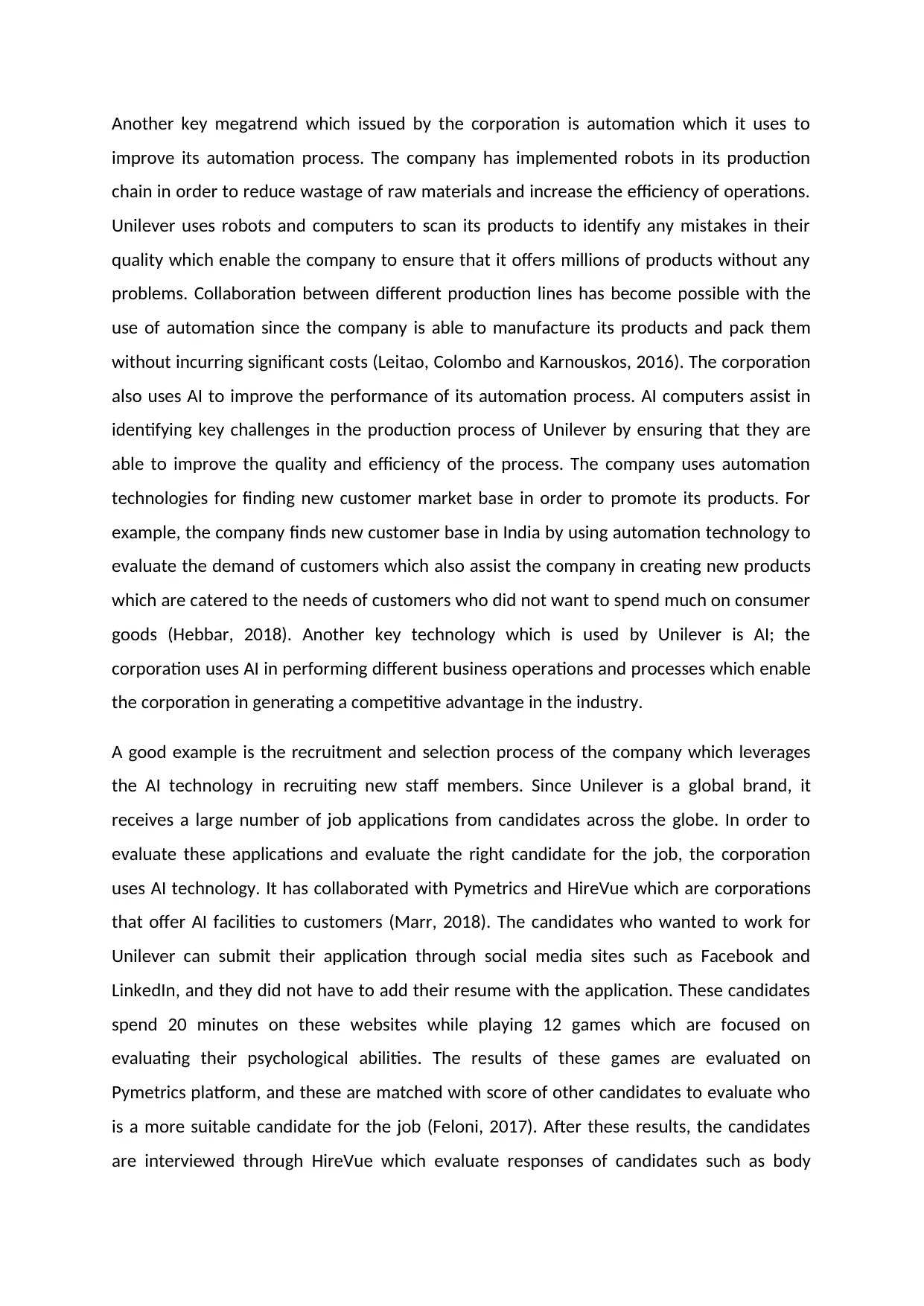
Another key megatrend which issued by the corporation is automation which it uses to
improve its automation process. The company has implemented robots in its production
chain in order to reduce wastage of raw materials and increase the efficiency of operations.
Unilever uses robots and computers to scan its products to identify any mistakes in their
quality which enable the company to ensure that it offers millions of products without any
problems. Collaboration between different production lines has become possible with the
use of automation since the company is able to manufacture its products and pack them
without incurring significant costs (Leitao, Colombo and Karnouskos, 2016). The corporation
also uses AI to improve the performance of its automation process. AI computers assist in
identifying key challenges in the production process of Unilever by ensuring that they are
able to improve the quality and efficiency of the process. The company uses automation
technologies for finding new customer market base in order to promote its products. For
example, the company finds new customer base in India by using automation technology to
evaluate the demand of customers which also assist the company in creating new products
which are catered to the needs of customers who did not want to spend much on consumer
goods (Hebbar, 2018). Another key technology which is used by Unilever is AI; the
corporation uses AI in performing different business operations and processes which enable
the corporation in generating a competitive advantage in the industry.
A good example is the recruitment and selection process of the company which leverages
the AI technology in recruiting new staff members. Since Unilever is a global brand, it
receives a large number of job applications from candidates across the globe. In order to
evaluate these applications and evaluate the right candidate for the job, the corporation
uses AI technology. It has collaborated with Pymetrics and HireVue which are corporations
that offer AI facilities to customers (Marr, 2018). The candidates who wanted to work for
Unilever can submit their application through social media sites such as Facebook and
LinkedIn, and they did not have to add their resume with the application. These candidates
spend 20 minutes on these websites while playing 12 games which are focused on
evaluating their psychological abilities. The results of these games are evaluated on
Pymetrics platform, and these are matched with score of other candidates to evaluate who
is a more suitable candidate for the job (Feloni, 2017). After these results, the candidates
are interviewed through HireVue which evaluate responses of candidates such as body
improve its automation process. The company has implemented robots in its production
chain in order to reduce wastage of raw materials and increase the efficiency of operations.
Unilever uses robots and computers to scan its products to identify any mistakes in their
quality which enable the company to ensure that it offers millions of products without any
problems. Collaboration between different production lines has become possible with the
use of automation since the company is able to manufacture its products and pack them
without incurring significant costs (Leitao, Colombo and Karnouskos, 2016). The corporation
also uses AI to improve the performance of its automation process. AI computers assist in
identifying key challenges in the production process of Unilever by ensuring that they are
able to improve the quality and efficiency of the process. The company uses automation
technologies for finding new customer market base in order to promote its products. For
example, the company finds new customer base in India by using automation technology to
evaluate the demand of customers which also assist the company in creating new products
which are catered to the needs of customers who did not want to spend much on consumer
goods (Hebbar, 2018). Another key technology which is used by Unilever is AI; the
corporation uses AI in performing different business operations and processes which enable
the corporation in generating a competitive advantage in the industry.
A good example is the recruitment and selection process of the company which leverages
the AI technology in recruiting new staff members. Since Unilever is a global brand, it
receives a large number of job applications from candidates across the globe. In order to
evaluate these applications and evaluate the right candidate for the job, the corporation
uses AI technology. It has collaborated with Pymetrics and HireVue which are corporations
that offer AI facilities to customers (Marr, 2018). The candidates who wanted to work for
Unilever can submit their application through social media sites such as Facebook and
LinkedIn, and they did not have to add their resume with the application. These candidates
spend 20 minutes on these websites while playing 12 games which are focused on
evaluating their psychological abilities. The results of these games are evaluated on
Pymetrics platform, and these are matched with score of other candidates to evaluate who
is a more suitable candidate for the job (Feloni, 2017). After these results, the candidates
are interviewed through HireVue which evaluate responses of candidates such as body
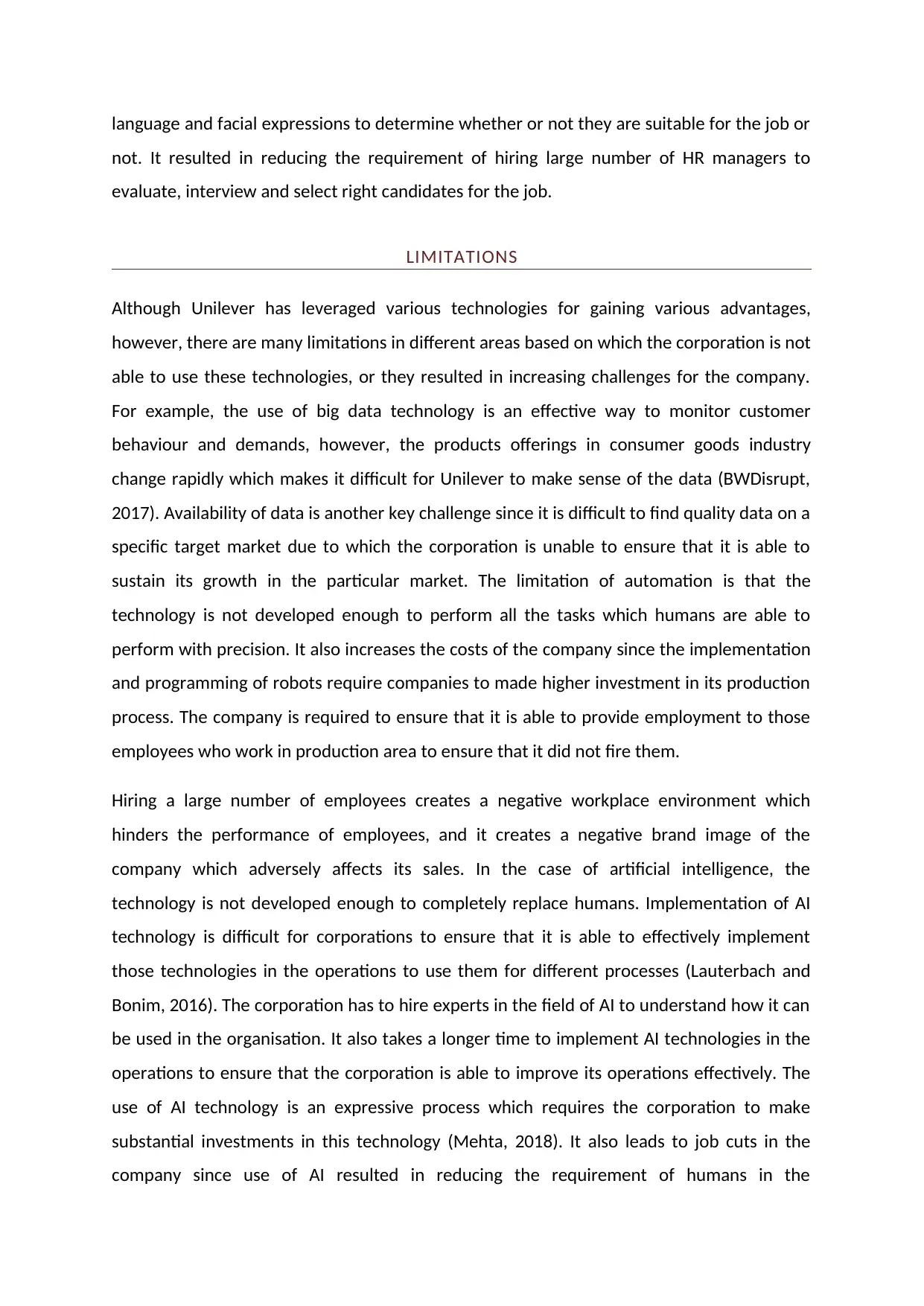
language and facial expressions to determine whether or not they are suitable for the job or
not. It resulted in reducing the requirement of hiring large number of HR managers to
evaluate, interview and select right candidates for the job.
LIMITATIONS
Although Unilever has leveraged various technologies for gaining various advantages,
however, there are many limitations in different areas based on which the corporation is not
able to use these technologies, or they resulted in increasing challenges for the company.
For example, the use of big data technology is an effective way to monitor customer
behaviour and demands, however, the products offerings in consumer goods industry
change rapidly which makes it difficult for Unilever to make sense of the data (BWDisrupt,
2017). Availability of data is another key challenge since it is difficult to find quality data on a
specific target market due to which the corporation is unable to ensure that it is able to
sustain its growth in the particular market. The limitation of automation is that the
technology is not developed enough to perform all the tasks which humans are able to
perform with precision. It also increases the costs of the company since the implementation
and programming of robots require companies to made higher investment in its production
process. The company is required to ensure that it is able to provide employment to those
employees who work in production area to ensure that it did not fire them.
Hiring a large number of employees creates a negative workplace environment which
hinders the performance of employees, and it creates a negative brand image of the
company which adversely affects its sales. In the case of artificial intelligence, the
technology is not developed enough to completely replace humans. Implementation of AI
technology is difficult for corporations to ensure that it is able to effectively implement
those technologies in the operations to use them for different processes (Lauterbach and
Bonim, 2016). The corporation has to hire experts in the field of AI to understand how it can
be used in the organisation. It also takes a longer time to implement AI technologies in the
operations to ensure that the corporation is able to improve its operations effectively. The
use of AI technology is an expressive process which requires the corporation to make
substantial investments in this technology (Mehta, 2018). It also leads to job cuts in the
company since use of AI resulted in reducing the requirement of humans in the
not. It resulted in reducing the requirement of hiring large number of HR managers to
evaluate, interview and select right candidates for the job.
LIMITATIONS
Although Unilever has leveraged various technologies for gaining various advantages,
however, there are many limitations in different areas based on which the corporation is not
able to use these technologies, or they resulted in increasing challenges for the company.
For example, the use of big data technology is an effective way to monitor customer
behaviour and demands, however, the products offerings in consumer goods industry
change rapidly which makes it difficult for Unilever to make sense of the data (BWDisrupt,
2017). Availability of data is another key challenge since it is difficult to find quality data on a
specific target market due to which the corporation is unable to ensure that it is able to
sustain its growth in the particular market. The limitation of automation is that the
technology is not developed enough to perform all the tasks which humans are able to
perform with precision. It also increases the costs of the company since the implementation
and programming of robots require companies to made higher investment in its production
process. The company is required to ensure that it is able to provide employment to those
employees who work in production area to ensure that it did not fire them.
Hiring a large number of employees creates a negative workplace environment which
hinders the performance of employees, and it creates a negative brand image of the
company which adversely affects its sales. In the case of artificial intelligence, the
technology is not developed enough to completely replace humans. Implementation of AI
technology is difficult for corporations to ensure that it is able to effectively implement
those technologies in the operations to use them for different processes (Lauterbach and
Bonim, 2016). The corporation has to hire experts in the field of AI to understand how it can
be used in the organisation. It also takes a longer time to implement AI technologies in the
operations to ensure that the corporation is able to improve its operations effectively. The
use of AI technology is an expressive process which requires the corporation to make
substantial investments in this technology (Mehta, 2018). It also leads to job cuts in the
company since use of AI resulted in reducing the requirement of humans in the
⊘ This is a preview!⊘
Do you want full access?
Subscribe today to unlock all pages.

Trusted by 1+ million students worldwide
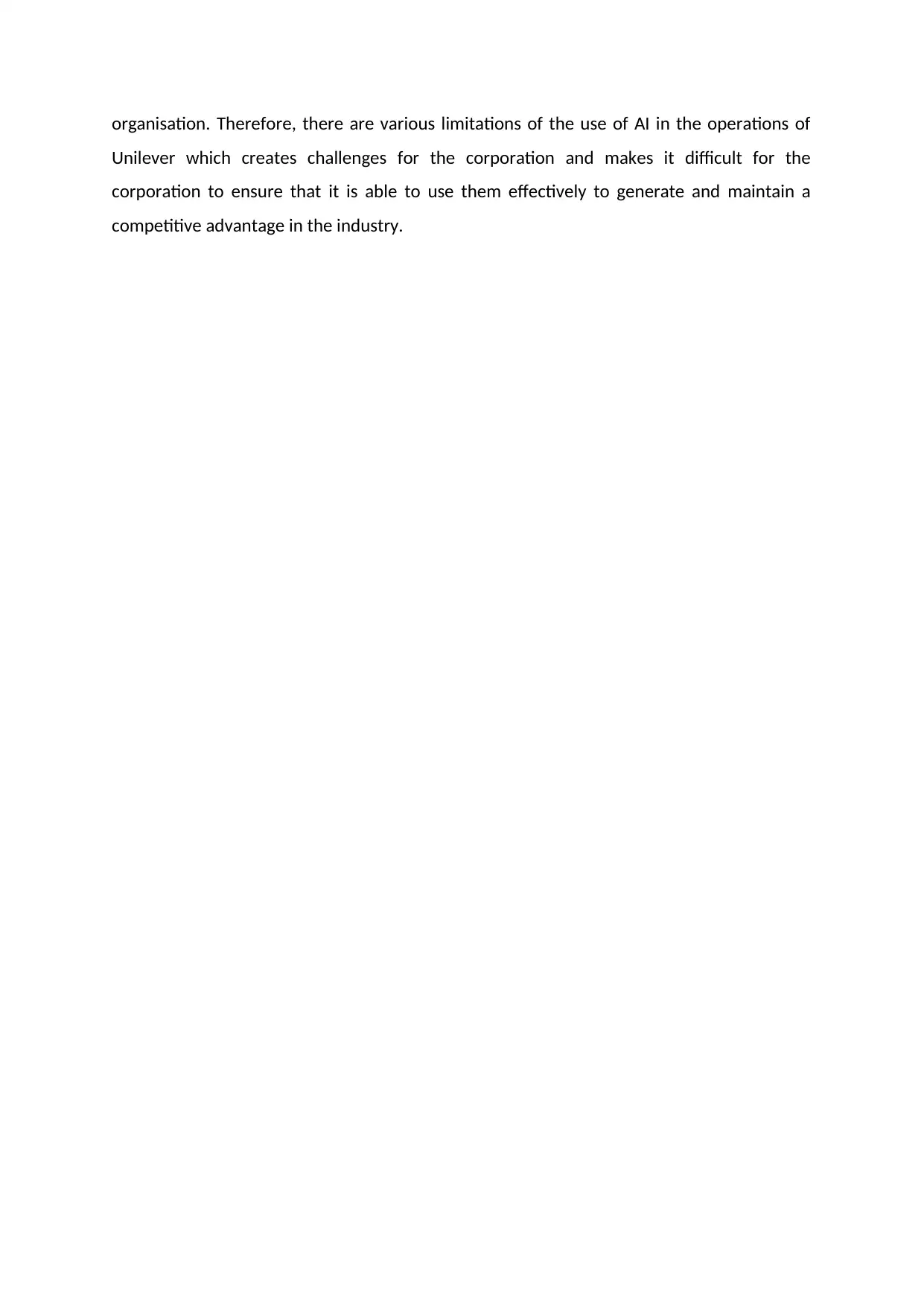
organisation. Therefore, there are various limitations of the use of AI in the operations of
Unilever which creates challenges for the corporation and makes it difficult for the
corporation to ensure that it is able to use them effectively to generate and maintain a
competitive advantage in the industry.
Unilever which creates challenges for the corporation and makes it difficult for the
corporation to ensure that it is able to use them effectively to generate and maintain a
competitive advantage in the industry.
Paraphrase This Document
Need a fresh take? Get an instant paraphrase of this document with our AI Paraphraser
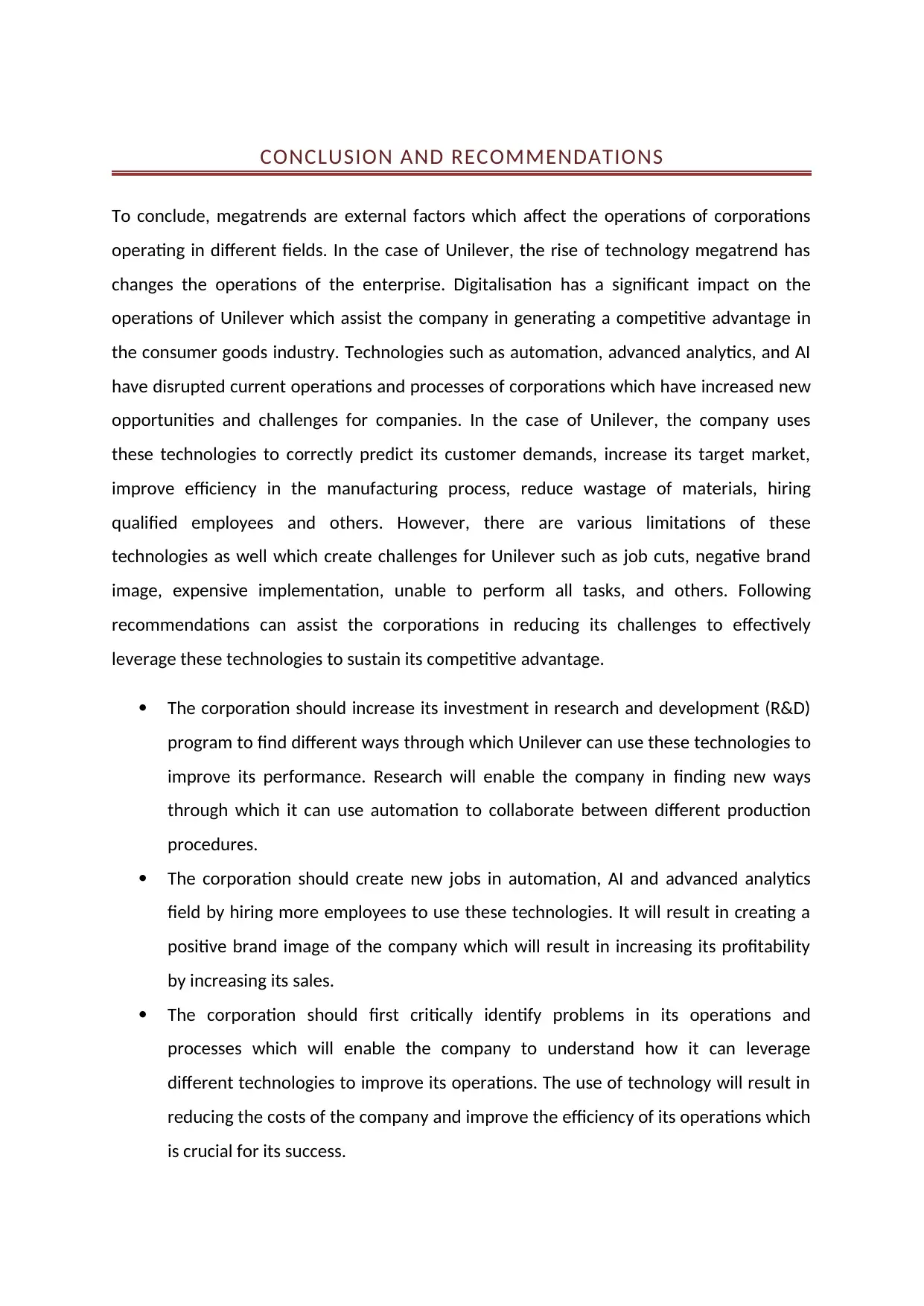
CONCLUSION AND RECOMMENDATIONS
To conclude, megatrends are external factors which affect the operations of corporations
operating in different fields. In the case of Unilever, the rise of technology megatrend has
changes the operations of the enterprise. Digitalisation has a significant impact on the
operations of Unilever which assist the company in generating a competitive advantage in
the consumer goods industry. Technologies such as automation, advanced analytics, and AI
have disrupted current operations and processes of corporations which have increased new
opportunities and challenges for companies. In the case of Unilever, the company uses
these technologies to correctly predict its customer demands, increase its target market,
improve efficiency in the manufacturing process, reduce wastage of materials, hiring
qualified employees and others. However, there are various limitations of these
technologies as well which create challenges for Unilever such as job cuts, negative brand
image, expensive implementation, unable to perform all tasks, and others. Following
recommendations can assist the corporations in reducing its challenges to effectively
leverage these technologies to sustain its competitive advantage.
The corporation should increase its investment in research and development (R&D)
program to find different ways through which Unilever can use these technologies to
improve its performance. Research will enable the company in finding new ways
through which it can use automation to collaborate between different production
procedures.
The corporation should create new jobs in automation, AI and advanced analytics
field by hiring more employees to use these technologies. It will result in creating a
positive brand image of the company which will result in increasing its profitability
by increasing its sales.
The corporation should first critically identify problems in its operations and
processes which will enable the company to understand how it can leverage
different technologies to improve its operations. The use of technology will result in
reducing the costs of the company and improve the efficiency of its operations which
is crucial for its success.
To conclude, megatrends are external factors which affect the operations of corporations
operating in different fields. In the case of Unilever, the rise of technology megatrend has
changes the operations of the enterprise. Digitalisation has a significant impact on the
operations of Unilever which assist the company in generating a competitive advantage in
the consumer goods industry. Technologies such as automation, advanced analytics, and AI
have disrupted current operations and processes of corporations which have increased new
opportunities and challenges for companies. In the case of Unilever, the company uses
these technologies to correctly predict its customer demands, increase its target market,
improve efficiency in the manufacturing process, reduce wastage of materials, hiring
qualified employees and others. However, there are various limitations of these
technologies as well which create challenges for Unilever such as job cuts, negative brand
image, expensive implementation, unable to perform all tasks, and others. Following
recommendations can assist the corporations in reducing its challenges to effectively
leverage these technologies to sustain its competitive advantage.
The corporation should increase its investment in research and development (R&D)
program to find different ways through which Unilever can use these technologies to
improve its performance. Research will enable the company in finding new ways
through which it can use automation to collaborate between different production
procedures.
The corporation should create new jobs in automation, AI and advanced analytics
field by hiring more employees to use these technologies. It will result in creating a
positive brand image of the company which will result in increasing its profitability
by increasing its sales.
The corporation should first critically identify problems in its operations and
processes which will enable the company to understand how it can leverage
different technologies to improve its operations. The use of technology will result in
reducing the costs of the company and improve the efficiency of its operations which
is crucial for its success.

⊘ This is a preview!⊘
Do you want full access?
Subscribe today to unlock all pages.

Trusted by 1+ million students worldwide
1 out of 15
Related Documents
Your All-in-One AI-Powered Toolkit for Academic Success.
+13062052269
info@desklib.com
Available 24*7 on WhatsApp / Email
![[object Object]](/_next/static/media/star-bottom.7253800d.svg)
Unlock your academic potential
Copyright © 2020–2025 A2Z Services. All Rights Reserved. Developed and managed by ZUCOL.





